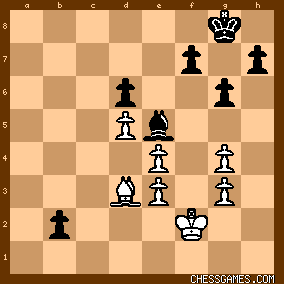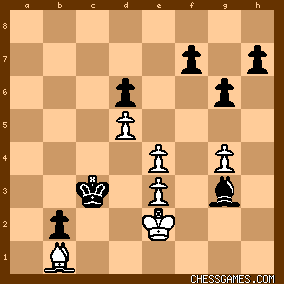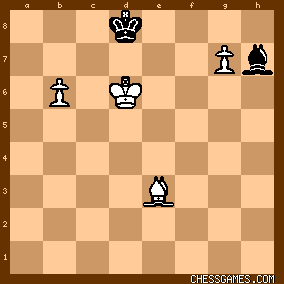Fusilli: Nice job by GM Joel. In the final position:

click for larger viewI think Black's plan is to bring the king all the way to c3-d2-c1 (assuming the white bishop is anchored on b1). The white bishop is stuck stopping the promotion and the white king is stuck defending the g3. But once the black king gets to c3, White will have to play Ke2 to stop it. Then Black captures the g3-pawn and at that point the position looks like this: 
click for larger viewBlack will produce a passer on the h-file and there is nothing White can do. When the king goes to stop the passer, the black king will overpower the bishop. To avoid an earlier annoying g5 from White (which wouldn't really work anyway since Black would play f6 and produce the h-passer anyway, but it would slow things down), Black can always play an early f6. This situation is particularly bad for White because his pawn structure is a disaster that makes his bishop horrible, but opposite-color bishop endings with passers on opposite sides of the board are normally won anyway. The problem for the defending side is that the king is too slow to travel from stopping one pawn to stopping the other one. Consider for example this bare bones position:

click for larger viewWhite wins here in many ways, but to illustrate the point, let's go with: 1.Ke6 (White threatens to go bully the bishop and force its sacrifice, so Black needs to send the king to help) Ke8 2.Kd6 Kd8 
click for larger view3.g6

click for larger viewBlack is in an impossible predicament. If he sends the king to stop the g-pawn, the white king overpowers the bishop. So, Black sends the bishop to stop the g-pawn: 3...Be4 4.g7 Bh7

click for larger view5.b7 and it's over.
Notice that in the last diagram, if it were Black's turn, White wins anyway after 1...Kc8 2.Ke7. The exception to the rule is a position like this: 
click for larger view... where Black can say "sure, white king, go overpower my bishop. I'll trade it for your pawn and it's a theoretical draw." Coincidentally, I lost to GM Joel at the recent US Senior Open and it was an opposite-color bishop ending with passers on both sides of the board. (That game will be uploaded in the near future.) | 




